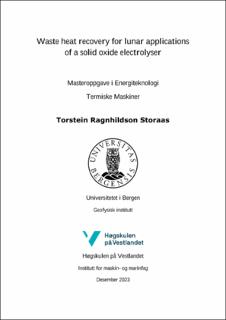| dc.contributor.author | Storaas, Torstein Ragnhildson | |
| dc.date.accessioned | 2024-02-15T00:40:00Z | |
| dc.date.available | 2024-02-15T00:40:00Z | |
| dc.date.issued | 2023-12-20 | |
| dc.date.submitted | 2023-12-20T11:06:45Z | |
| dc.identifier | ENERGI399K 0 MAO ORD 2023 HØST | |
| dc.identifier.uri | https://hdl.handle.net/11250/3117829 | |
| dc.description.abstract | In an effort to make space exploration more sustainable the space industry looks to In-Situ Resource Utilisation (ISRU) as a possible way to lower the cost. With confirmed findings of water ice on the south pole of Earth’s moon oxygen extraction with the help of Solid Oxide Electrolysis (SOE) is being investigated. SOE is a high temperature electrolysis technology with a high tolerance for impurities in its fuel stream. This makes SOE a promising technology for use in lunar ISRU production of oxygen. As an implication of its high operating temperature, thermal management is an important factor in lowering the overall energy demand of the electrolysis.
This report will investigate the waste heat recovery potential in the product gases from an SOE intended for oxygen production on the Moon. The SOE has an assumed electric power consumption and mass of approximately 13 kW and 26 kg respectively. Heat exchangers are investigated as a solution to recover the high temperature thermal energy in the product gases from the SOE in order to preheat steam that is supplied to it.
The commercially available design program Aspen Exchange Design and Rating (EDR) is used to design and compare different types and configurations of heat exchangers.
The results show that there is sufficient thermal energy to warrant the implementation of waste heat recovery. When using plate heat exchangers results show estimated power savings of between 1.3 kW and 1.5 kW depending on the size and configuration of the heat exchanger chosen.
The different configurations of the plate heat exchangers did not impact the amount of recovered heat in a meaningful way indicating that other considerations should be made when deciding on the design. The results for a configuration using a three-stream plate fin heat exchanger were unconclusive.
The mass flows of ca. 3 kg steam per hour for the specific SOE system under investigation were close to the lower mass flow limit of Aspen EDR. For further and more detailed investigations the use of a heat exchanger design software developed for such low mass flows is recommended. | |
| dc.language.iso | eng | |
| dc.publisher | The University of Bergen | |
| dc.rights | Copyright the Author. All rights reserved | |
| dc.subject | SOE | |
| dc.subject | ISRU | |
| dc.subject | waste heat | |
| dc.subject | heat exchanger | |
| dc.subject | moon | |
| dc.subject | lunar | |
| dc.title | Waste heat recovery for lunar applications of a solid oxide electrolyser | |
| dc.type | Master thesis | |
| dc.date.updated | 2023-12-20T11:06:45Z | |
| dc.rights.holder | Copyright the Author. All rights reserved | |
| dc.description.degree | Masteroppgave i energi | |
| dc.description.localcode | ENERGI399K | |
| dc.description.localcode | MAMN-ENERG | |
| dc.subject.nus | 752903 | |
| fs.subjectcode | ENERGI399K | |
| fs.unitcode | 12-44-0 | |
